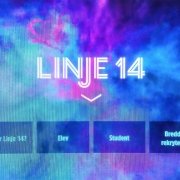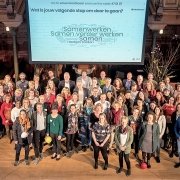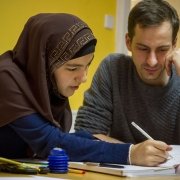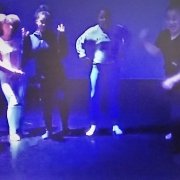*peppa girls’ centre
Excerpt
*peppa girls’ centre is a project by the Caritas of the Archdiocese of Vienna, Austria. It was implemented in 2009 and has since offered a space exclusively for immigrant, refugee or Austrian girls and young women for recreational activities, intercultural dialogue and mutual acquaintance. Moreover, it initiates demand-oriented programs for supporting the target group between the ages of 10 and 20 within their individual life circumstances. All activities, workshops and advisory services are anonymous, free of charge and easily accessible. On average, *peppa is frequented by about 30-40 girls per day.
Narrative, origins and objectives of the initiative
What kind of project is this? Please give a short description (summary) of it.
*peppa girls’ centre is a project by the Caritas of the Archdiocese of Vienna. It was implemented in 2009 and has since offered a space exclusively for immigrant, refugee or Austrian girls and young women for recreational activities, intercultural dialogue and mutual acquaintance. Moreover, it initiates demand-oriented programs for supporting the target group between the ages of 10 and 20 within their individual life circumstances. All activities, workshops and advisory services are anonymous, free of charge and easily accessible. On average, *peppa is frequented by about 30-40 girls per day.
Please tell us why, in general, this project is considered a successful one?
The *peppa girls’ centre is considered a successful project because it offers a very broad range of services for girls and young women, as education and job counselling, individual counselling and specifically tailored case work, health and sexuality counselling, support in dealing with institutions, etc. In 2017 the number of offered activities included: 116 days of learning assistance, 53 Workshops and 33 Excursions, 430 counsellings, 436 telephone counsellings, 11 accompaniments to other institutions and 16 crisis interventions. The most common counselling topics were: education, family situation, living, mental health, employment, financial situation, physical health, crisis situation, relationship, violence/abuse, residency as well as cultural issues. Another factor that determines the success of the project is that all activities, workshops and advisory services are anonymous, free of charge and easily accessible. Furthermore all services focus on the young girls’ personal needs, wants, interests, desires and goals.
And why would you consider it a grass-roots initiative?
The *peppa girls’ centre responds to the ever-changing and developing needs, wants, interests, desires and goals of girls and young women and actively incorporates participation.
What challenges needed to be solved in this project?
Inequalities on the grounds of gender, ethnicity, class religion etc. need to be solved.
Is this initiative based on any particular theoretical framework? Which one?
Youth work and more specifically girls’ work in migration society and the principles of girls’ work (participation, partiality, relationship work etc.).
The objectives of *peppa are to encourage self-determination, reflexivity and autonomy; to promote well-being, equal opportunities and participation; and to support a positive gender and cultural identity, an appreciation of various life projects and an understanding of structural possibilities.
Encourage and strengthen:
- self-determination and emancipation
- creative potential and self reflexivity
- autonomy and participation
Promote:
- psychological and physical well-being
- equal opportunities
- participation in society
*peppa supports the development of:
- a positive gender and cultural identity
- an appreciation of various cultures, nationalities and life projects
- an understanding of social structural possibilities and boundaries
- enables future economic independence
- supports and accompanies in conflict situations and during difficult life phases
(Appendix) Is your intervention standing on its own or is it a part of a bigger and more holistic approach?
From the organization – approach: help people in need. It is based on the context of youth work and women’s issues: intercultural girls’ work
Please describe the group(s) intended as beneficiaries of this initiative
Why has this group (have these groups) been chosen?
The target group involves migrant, refugee and Austrian girls and young women between the ages of 10 to 20.
Why? Because of their precarious socio-economic situation and educational pathways, inequalities on the grounds of gender, religion, ethnicity, class etc.
Could you please tell us something about the relative size of the (of each) target group, within the school/university population, region and/or country?
Around 520 different girls and young women visited *peppa in 2017.
Which social characteristics are taken into account and what is the geographical area covered?
Geographical area: all of Vienna and beyond, focus on the 16th district and neighboring districts.
More than one third of the population in Vienna has a migration or refugee background, the 16th district has more than the Viennese average. Around half of the population with a migrant background is female. Their population is marked by lower income, lower educational attainment, and NEETs.
On which level is the project implemented?
> Immigrant, refugee and Austrian girls and young women between the ages of 10 to 20
> Implemented on local level
Please describe the political and socio-economic factors that you believe have been important enablers for your initiative
Did the initiative have political support?
The political support differed depending on local, regional and national level and changes in administration.
How did it fit with local, regional or national policies?
The political support differed depending on local, regional and national level as well as changes in administration.
Beneficial: focus on young women & integration
Difficulties in regards to competences: inter-sectional approach combining integration, gender, education, age etc.
Who are the stakeholders supporting the initiative?
*peppa girls’ centre is a project of Caritas of the Archdiocese of Vienna
Many stakeholders such as social institutions and NGOs support the initiative.
Are there particular demographic changes present that are influencing the project?
A rising number of refugees (since 2015), and before that, more girls with an immigrant background.
What is the institutional strategy and culture of the (educational) organization?
To help people in need!
To what extent does the initiative have an influence on institutional policy (or potential influence) of the (educational) organization?
It is difficult to answer in face of the size of the organization and the level on which this is answered.
(Appendix) Is there public support for your initiative and the issue it addresses?
There are points in time when it is more supported and interest from media is noticeable. Supporting young immigrant, refugee and Austrian women is generally seen positively, but there are also other political and public viewpoints.
(Appendix) What other factors do you think have been important for the success of this initiative?
Mainly the demand from the target group.
Please describe the overall initiative design and the methods and tools used to reach the goals
Please describe the specific activities carried out.
*peppa offers a safe space for:
- immigrant, refugee and Austrian girls and young women between the ages of 10 to 20 years old
- recreational activities, learning assistance, counselling
- anonymous services, free of charge and easily accessible
The *peppa girls’ center is a safe space for recreational activities, intercultural dialogue and mutual acquaintance (Opening hours Mo-Fr after school hours)
It offers:
- Safe space for girls and young women
- Learning assistance
- Workshops (i.e. computer skills, photography, self-defence, dancing, video, urban gardening, upcycling)
- Space to play and chill
- Multilingual library
- Excursions, parties and events
- Individual counselling
- Group talks
- Education and job counselling
- Social counselling and health counselling
What were the key roles (teacher, student, management team etc.) within the project?
1 team leader, 1 project assistant, 4 youth workers/counselors
What ideas, tools, theories, models, methodology (etc.) have been used to reach the goals?
Learning assistance, infrastructure for education, counselling, crisis intervention, workshops, excursions, networking, lobbying, accompaniments, volunteers support, relationship work, social group work.
What are the final revenues of the project?
See above
Please describe if your project ensured its sustainability
If so, how did you ensure the short-term impact of the project?
Short-term: the activities support girls and young women in their daily needs (see above).
And how did you ensure the long-term impact of the project?
Long-term: the activities of *peppa contribute to emancipation of young women and supporting their role in society; change of society (equality, integration).
Has your project been replicated elsewhere?
There are other projects in other districts/cities/countries for girls and young women, sometimes with a different or more specific focus. Some are very similar, but no replicas as far as information available.
Please tell us about the resources used in this initiative
What was the budget for the initiative?
Around 400.000 € per year
Constantly changing: public and private funding, as well as donations.
How much did the initiative depend on volunteers?
There are many volunteers supporting the work of *peppa, mainly in relation to learning assistance. Furthermore, there is a volunteer from the European Voluntary Service every year.
How were the costs perceived by the public/the sector/other stakeholders?
The costs are usually seen as adequate and the project has been praised for its economic efficiency.
To what extent did the initiative achieve its objectives?
Please describe the evidence to support the success of your initiative.
The evidence of the success lies in the rising numbers of girls and young women taking part in the activities, in individual life improvements and changes to the local community.
Did the intervention lead to any unintended (positive) outcomes?
There were many unintended positive outcomes, too many to count, but mainly positive individual life stories.
What indicators (quantitative and qualitative) have you measured to demonstrate success?
In 2017 around 520 different girls and young women attended the *peppa girls’ centre.
See also the numbers above on activities.
Qualitatively we measure our success through supervision, team meetings, seminars etc as well as through reporting.
(Appendix) How did you evaluate/monitor this intervention?
See above

 Caritas Wien/Stefanie Starz
Caritas Wien/Stefanie Starz


 Sale für Alle 2018
Sale für Alle 2018

